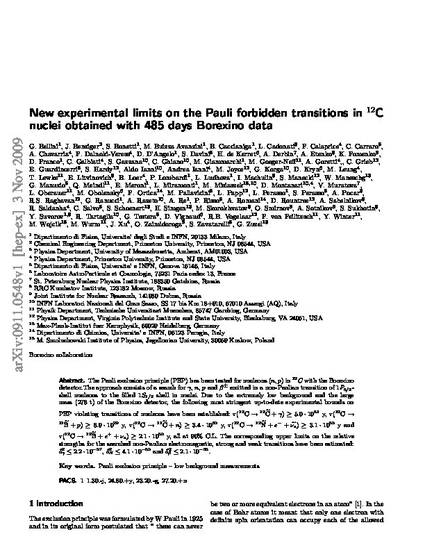
Article
New Experimental Limits on the Pauli-Forbidden Transitions in 12C Nuclei Obtained with 485 Days Borexino Data
Physical Review C
(2010)
Abstract
The Pauli exclusion principle (PEP) has been tested for nucleons (n,p) in 12C with the Borexino detector. The approach consists of a search for γ, n, p, and β± emitted in a non-Paulian transition of 1P3/2-shell nucleons to the filled 1S1/2 shell in nuclei. Due to the extremely low background and the large mass (278 tons) of the Borexino detector, the following most stringent up-to-date experimental bounds on PEP violating transitions of nucleons have been established: τ(12C→12C~+γ)⩾5.0×1031 yr, τ(12C→11B~+p)⩾8.9×1029 yr, τ(12C→11C~+n)⩾3.4×1030 yr, τ(12C→12N~+e-+νe~)⩾3.1×1030 yr, and τ(12C→12B~+e++νe)⩾2.1×1030 yr, all at 90% C.L. The corresponding upper limits on the relative strengths for the searched non-Paulian electromagnetic, strong and weak transitions have been estimated as δγ2⩽2.2×10-57, δN2⩽4.1×10-60, and δβ2⩽2.1×10-35.
Keywords
- Pauli exclusion principle,
- low background measurements
Disciplines
Publication Date
March 29, 2010
Publisher Statement
This is the pre-published version harvested from arXiv. The published version is located at http://prc.aps.org/abstract/PRC/v81/i3/e034317
Citation Information
G. Bellini, J. Benziger, S. Bonetti, M. Buizza Avanzini, et al.. "New Experimental Limits on the Pauli-Forbidden Transitions in 12C Nuclei Obtained with 485 Days Borexino Data" Physical Review C Vol. 81 Iss. 3 (2010) Available at: http://works.bepress.com/andrea_pocar/9/
